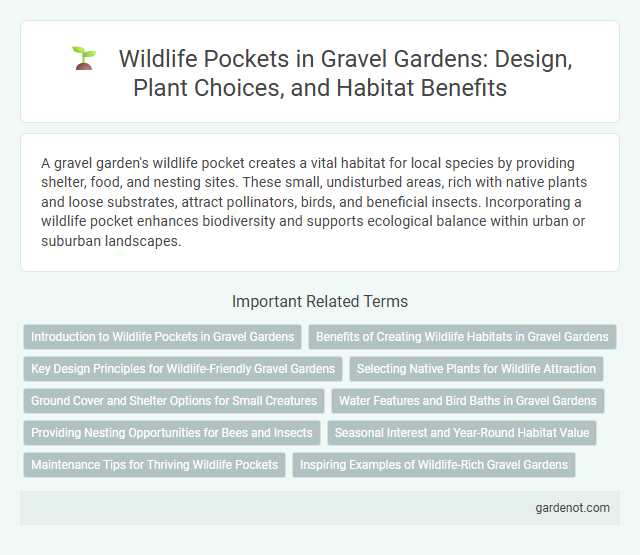A gravel garden's wildlife pocket creates a vital habitat for local species by providing shelter, food, and nesting sites. These small, undisturbed areas, rich with native plants and loose substrates, attract pollinators, birds, and beneficial insects. Incorporating a wildlife pocket enhances biodiversity and supports ecological balance within urban or suburban landscapes.
Introduction to Wildlife Pockets in Gravel Gardens
Wildlife pockets in gravel gardens provide essential habitats for native insects, birds, and small mammals, enhancing biodiversity within urban and suburban settings. These carefully designed microhabitats include features such as log piles, native wildflowers, and shallow water sources that attract pollinators like bees and butterflies. Incorporating wildlife pockets supports ecological balance and promotes sustainable gardening by creating refuge areas amidst gravel landscapes.
Benefits of Creating Wildlife Habitats in Gravel Gardens
Creating wildlife habitats in gravel gardens supports biodiversity by providing shelter and food sources for pollinators, birds, and beneficial insects. These habitats enhance ecological balance, promoting natural pest control and improving plant health. Integrating native plants in wildlife pockets encourages habitat connectivity, benefiting local ecosystems and contributing to conservation efforts.
Key Design Principles for Wildlife-Friendly Gravel Gardens
Wildlife-friendly gravel gardens prioritize native plant species that provide nectar, seeds, and shelter for insects, birds, and small mammals. Incorporating varied gravel sizes and organic matter creates microhabitats ideal for ground-nesting bees and beetles. Strategic placement of logs, stones, and water features enhances biodiversity by offering refuge and hydration for diverse wildlife species.
Selecting Native Plants for Wildlife Attraction
Selecting native plants for a wildlife pocket in a gravel garden enhances local biodiversity by providing essential food and shelter for native insects, birds, and pollinators. Plants like echinacea, milkweed, and goldenrod thrive in well-drained gravel soil while supporting pollinators such as bees and butterflies. Incorporating a variety of native grasses and flowering perennials ensures habitat complexity and year-round resources for wildlife attraction.
Ground Cover and Shelter Options for Small Creatures
Gravel gardens provide ideal ground cover for small creatures by combining loose stones with hardy, low-growing plants such as creeping thyme and sedum that retain moisture and offer protection. Small wildlife like insects, amphibians, and reptiles find shelter under stone piles, dense clumps of ground cover, and hollowed driftwood, creating microhabitats essential for survival. Incorporating diversity in substrate and plant structure enhances biodiversity and supports beneficial ecosystems within gravel garden spaces.
Water Features and Bird Baths in Gravel Gardens
Water features and bird baths in gravel gardens create vital wildlife pockets by providing essential hydration and bathing spots for birds and insects. These elements attract pollinators, amphibians, and small mammals, supporting biodiversity within the dry, well-drained soil environment typical of gravel gardens. Integrating shallow basins or recirculating water fountains enhances habitat quality while maintaining the low-maintenance aesthetic of gravel grounds.
Providing Nesting Opportunities for Bees and Insects
A gravel garden's wildlife pocket offers essential nesting opportunities for solitary bees and beneficial insects by incorporating bare soil patches and hollow stems. These habitats support biodiversity by providing safe breeding grounds crucial for pollination throughout the growing season. Creating varied microhabitats within gravel gardens enhances insect populations, promoting a healthy ecosystem.
Seasonal Interest and Year-Round Habitat Value
Gravel gardens with wildlife pockets provide vital seasonal interest by supporting a diverse range of pollinators and birds throughout the year. Native wildflowers and hardy shrubs within these pockets bloom sequentially, ensuring continuous nectar sources from spring to autumn. These habitats offer year-round refuge and food supply, enhancing biodiversity and promoting ecological balance in urban and suburban settings.
Maintenance Tips for Thriving Wildlife Pockets
Regularly removing invasive weeds in a wildlife pocket ensures native plants thrive, providing essential food and shelter for local fauna. Incorporating seasonal watering routines supports diverse insect populations, crucial for pollination and bird feeding. Minimal soil disturbance and mulching promote healthy root systems, enhancing habitat stability for ground-nesting insects and small mammals.
Inspiring Examples of Wildlife-Rich Gravel Gardens
Wildlife-rich gravel gardens create ideal habitats by incorporating native plants, wildflower patches, and log piles that attract pollinators, birds, and beneficial insects. Gardens like the RHS Wisley gravel garden showcase diverse pollinator-friendly species such as lavender, thyme, and sedums, enhancing biodiversity. These inspiring examples demonstrate how gravel gardens provide food, shelter, and nesting sites, supporting a thriving ecosystem in urban and suburban settings.
Wildlife pocket Infographic

 gardenot.com
gardenot.com